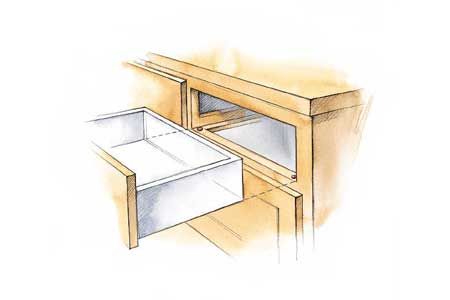Worn drawers are a common issue in older desks, dressers, and other furniture pieces. Over time, the constant friction between the drawer and its runners can lead to wear and tear, causing the drawer to sit unevenly or stick when opened.
However, there are several quick and easy ways to restore your drawers without replacing them. In this guide, we’ll discuss common drawer issues, simple fixes, and when it’s time to seek professional help.
Causes of Drawer Wear and Tear
Let’s explore the main factors contributing to drawer deterioration.
Wood-on-Wood Friction
Many older pieces of furniture feature a simple wood-on-wood friction system for drawer operation. While this design can be effective, it’s also prone to wear over time. As the drawer slides in and out, the constant rubbing between the wooden surfaces gradually erodes the material, leading to uneven movement and misalignment.
Age and Frequent Use
Over the years, wood may expand, contract, or warp due to changes in temperature and humidity. This can affect the fit of the drawer within its frame, leading to increased friction and wear on specific points of contact.
Poor Initial Construction
In some cases, drawer issues may stem from subpar initial construction. Drawers that weren’t properly fitted or aligned from the start are more likely to develop problems over time. This can include issues like uneven drawer bottoms, misaligned sides, or improperly installed runners.
Tools and Materials Needed for Fixing Worn Drawers
Before diving into repairs, gather the following items:
- Large thumbtacks
- Thin cardboard (for shims)
- Candle wax or paraffin
- Silicone-based lubricant
- Screwdriver
- Fine-grit sandpaper
- Clean cloth
Having these materials on hand will allow you to try various quick fixes without multiple trips to the hardware store.
Fixes for Drawers Sitting Too Low
One of the easiest and most effective solutions for worn drawers is the thumbtack trick. This method is particularly useful for drawers that have begun to tip downward when pulled out.
This simple fix elevates the drawer slightly, compensating for the worn bottom edges of the drawer sides. Here are the steps you should take:
- Remove the drawer from the furniture piece.
- Locate the wear points on the face frame where the drawer sides make contact.
- Press a large thumbtack into the face frame on each side of the drawer opening.
- Ensure the thumbtacks are securely in place and level with each other.
- Slide the drawer back in, allowing it to rest on the thumbtacks.
Fine-Tuning with Cardboard Shims
If the drawer still sits too low after applying the thumbtack trick, you can make further adjustments. Try the following steps:
- Remove the drawer again.
- Cut small pieces of thin cardboard to use as shims.
- Place these cardboard shims under each thumbtack.
- Press the thumbtacks back into place, securing the shims.
- Reinsert the drawer and test its positioning.
Add or remove shims as needed until the drawer sits at the desired height and operates smoothly.
Fixes for Sticky Drawers
While the thumbtack method is effective, there are other simple solutions you can try to improve drawer function.
Wax Application Technique
Applying wax to the drawer runners can reduce friction and smooth out drawer operation. Take the following steps:
- Remove the drawer and clean the runners thoroughly.
- Rub a candle or block of paraffin wax along the drawer runners and the bottom edges of the drawer sides.
- Work the wax into the wood, ensuring even coverage.
- Reinsert the drawer and slide it back and forth to distribute the wax.
Drawer Slide Lubricant Options
For metal drawer slides or stubborn wooden runners, a silicone-based lubricant can be highly effective. This is how to lubricate your drawers:
- Clean the drawer slides or runners to remove any dust or debris.
- Apply a small amount of silicone lubricant to the slides or runners.
- Spread the lubricant evenly using a clean cloth.
- Reinsert the drawer and operate it several times to distribute the lubricant.
Avoid using oil-based lubricants, as they can attract dust and potentially damage wood over time.
Preventive Measures to Extend Drawer Life
Here are a few ways you can regularly maintain your drawers:
- Clean drawers and runners regularly to prevent the buildup of dust and debris.
- Inspect drawers annually for signs of wear or damage.
- Apply a fresh coat of wax or lubricant to runners every 6-12 months.
- Tighten any loose screws or hardware promptly.
Avoid overloading your drawers, especially with heavy items. Distribute weight evenly within each drawer, and consider using drawer organizers to prevent items from shifting and causing uneven wear.
When to Consider Drawer Runner Replacement
While quick fixes can address many drawer issues, there may come a time when more extensive repairs are necessary. Assessing the condition of your furniture and its runners can help you decide when it’s time for a more permanent solution. Here are a few signs it may be time for new drawers:
- Severe warping or damage to the drawer or runners
- Persistent sticking or misalignment despite quick fixes
- Visible cracks or splits in the wood
- Drawer sides that have worn down significantly
Types of Replacement Drawer Runners
When replacing drawer runners, you have several options, such as the following:
- Wooden runners: Traditional and aesthetically pleasing for antique furniture
- Metal ball-bearing slides: Smooth operation and increased durability
- Soft-close slides: Prevent slamming and provide a luxurious feel
Our Conclusion
Worn drawers don’t have to mean the end of your favorite furniture pieces. With simple solutions like the thumbtack trick, waxing, or lubrication, you can often restore smooth operation quickly and easily. Regular maintenance and proper use can also prevent many drawer issues, extending the life of your furniture.

